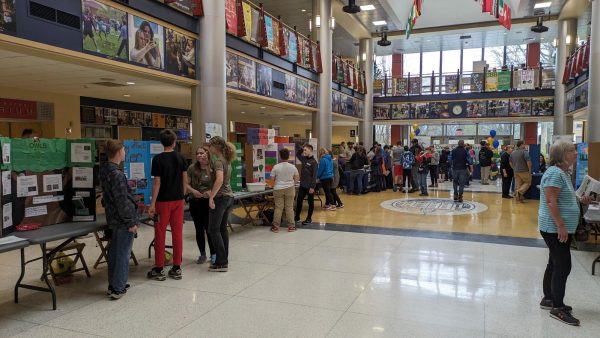Dance minor’s concert gives new goal to dancing
Performers glided across the stage as the audience silently watched and interpreted their pieces. The Allegheny dance department presented their Dance Minor’s Concert on Sunday, April 23, in the Montgomery Performance Space.
There are many dance organizations on campus, like the Jazz and Dance Ensemble and the Orchesis Dance Company. The dance minor’s concert is a performance that seeks to give the performers a space where they can choreograph dances personal to them.
Dance and Movement Studies Instructor Betsy Sumerfield said the purpose of the concert is for the choreographer to explore a concept rather than to entertain the audience. Through the concert, the choreographers were able to explore themes like coming of age and identity.
“Hopefully they will be entertained on some level,” Sumerfield said. “But it could also be that the choreographer wants to make the audience think or that the choreographer has something specific they want to say and so they figure out how to say it using dance.”
The concert featured four pieces choreographed by Keely Skultety, ’23, Jillian Bradley, ’23, Abby Wolff, ’23, and Haley Fabich, ’24. Each choreographer was able to choose their own subject and theme for their dance and could have anyone participate in their piece regardless of their dance experience.
Wolff said her piece was inspired by the song “Rainbow” by Kesha, and she wanted to perform a song that was close to her.
“I always had an attachment to the song because I feel like it just speaks to me so much and has such a deeper meaning of growing into yourself,” Wolff said.
“There is a moment in the song where it says, ‘our scars make us who we are’ and I was like ‘same.’”
Despite the performances having a less audience-based goal, Wolff said she still wanted them to understand the message she was sending through her dance.
“I really listened to it and thought about what I wanted the audience to perceive from what I was showing,” Wolff said. “I feel like if you really sit and listen to the lyrics of the song, my movements go along pretty much with it. It’s not acting or pantomiming but it’s just kind of like feeling the song.”
Jenna Monteleone, ’23, who was involved in the concert last year and was in charge of behind-the-scenes planning this year, encouraged people to see the concert because of the unique dances. Monteleone said that her involvement in other dance groups has been more targeted to the audience while her experience with the Dance Minor’s Concert has been more about self-expression.
“I think that the style of dance is really interesting because it can be interpreted in so many different ways and there is not a clear storyline or plot going on,” Monteleone said. “Many times, people and an audience will actually get emotional just from watching a piece because it stirs something in them and they felt connected in them.”
Monteleone said students from all dance levels can be asked to dance by the choreographer because the types of movements are different.
“The kinds of movements that we do in a Dance Minor’s Concert or like a creative process class are much more mechanical and pedestrian-like movements,” Monteleone said. “Because there are not any criteria that have to be met like pointed toes or straight legs, it allows the choreographer a lot more freedom and then, therefore, the dancers.”
Monteleone said that having a dance concert aimed at creativity has helped her develop more sets of skills aside from the act of dancing.
“It is definitely challenging in many different ways and in my experience choreographing in both styles has helped me develop my sense of self,” Monteleone said. “It is very vulnerable to share choreography that is not aimed as a performance.”
Sumerfield said she advises students to always have a clear voice in their head about what they want to say and to not rely on entertainment or big tricks. While participating in the concert is no longer required for the dance minor, it is strongly recommended that students be involved with the concert in some way.
“It gives students a chance to put what they have learned on stage and let their voice be heard and seen,” Sumerfield said. “It brings a sense of learning and dedication that they may or may not already have through their home studios.”

Evelyn Zavala is a senior from San Francisco. She is majoring in Business and minoring in Journalism in the Public Interest. This is her fourth year on...






